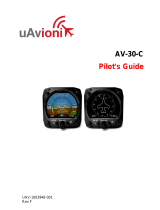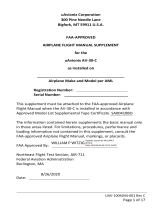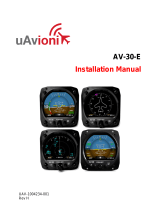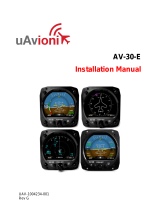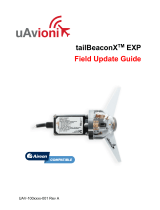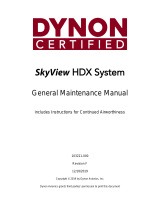Page is loading ...

UAV-1003947-001
Rev K
AV-30-C
Installation Manual

UAV-1003947-001, AV-30-C, Installation Manual 2
Rev K
© 2020 - 2023 uAvionix Corporation. All rights reserved.
uAvionix Corporation
Bigfork, MT
www.uavionix.com
support@uavionix.com
Except as expressly provided herein, no part of this guide may be
reproduced, transmitted, disseminated, downloaded, or stored in any storage
medium, for any purpose without the express written permission of uAvionix.
uAvionix grants permissions to download a single copy of this guide onto an
electronic storage medium to be viewed for personal use, provided that the
complete text of this copyright notice is retained. Unauthorized commercial
distribution of this manual or any revision hereto is strictly prohibited.
uAvionix® and Ping® are registered trademarks of uAvionix Corporation and
may not be used without express permission of uAvionix.
AV-30, AV-30-E, AV-30-C, AV-Mag, AV-Link, BeaconX, tailBeaconX, and
skyBeaconX are trademarks of uAvionix Corporation and may not be used
without express permission of uAvionix.
Patents www.uavionix.com/patents

UAV-1003947-001, AV-30-C, Installation Manual 3
Rev K
1 Revision History
Revision
Date
Comments
A
4/24/2020
Initial release
B
7/13/2020
Added installation log-book entry requirement.
Added method to determine proper screw
length. Highlighted primary functions. Added
items included in the ICA. Added startup time
and AoA reference per MOPS requirement.
Added reference to CFR 23.1321.
C
8/10/2020
Added reference to AoA operation in inverted
flight and operation in excess of G limits.
Added reference to utilize wire type in
accordance with AC 43.13-1B.
D
6/3/2021
Updated Top Level Assembly references.
E
9/2/2021
Software update to 2.1.2
Added Definition of Acronyms & Terms section
Added requirement for pitot / static connection
Add vibration check to System Checkout
F
12/3/2021
Software update to 2.1.4
Update mounting screw length guidance
Add transponder control
G
5/10/2022
Update Installation Limitations
Update battery guidance
Update trim guidance
Update mislabeled note on DG wiring diagram
H
9/29/2022
Software update to 2.1.5
Add display of bootloader version number.
Add BeaconX Ground Test Mode
I
2/15/2023
Add SAE AS8013A to Table 2 - Applicable
Performance Standards
Add Serial 4 to Serial Inputs
Add AV-Mag optional equipment description
Add AV-Mag to pinout diagram
Add AV-Mag wire color coding table
Add AV-Mag installation and calibration
Add display of AV-Mag software part number
and software version number
Add Pitot zero-point field calibration
Add Multi-point altitude field calibration
Change pitch trim limits to +-27 degrees

UAV-1003947-001, AV-30-C, Installation Manual 4
Rev K
Add additional fields to Table 10 Installation
Menu Setting
magnetometer calibration needed
Add AV-Link and AV-Mag to trademarked
terms list
J
5/10/2023
Add AV-Mag parallel operation
Add field update pins to wiring and pin
diagrams
Clarify airspeed and altimeter limitation
Describe installation kit contents
Add tailBeaconX parallel operation figure
K
8/10/2023
Fix reference and update units on IAS Vspeeds

UAV-1003947-001, AV-30-C, Installation Manual 5
Rev K
2 Warnings / Disclaimers
All device operational procedures must be learned on the ground.
uAvionix is not liable for damages arising from the use or misuse of this
product.
This equipment is classified by the United States Department of Commerce's
Bureau of Industry and Security (BIS) as Export Control Classification
Number (ECCN) 7A994.
These items are controlled by the U.S. Government and authorized for
export only to the country of ultimate destination for use by the ultimate
consignee or end-user(s) herein identified. They may not be resold,
transferred, or otherwise disposed of, to any other country or to any person
other than the authorized ultimate consignee or end-user(s), either in their
original form or after being incorporated into other items, without first
obtaining approval from the U.S. government or as otherwise authorized by
U.S. law and regulations.

UAV-1003947-001, AV-30-C, Installation Manual 6
Rev K
3 Limited Warranty
uAvionix products are warranted to be free from defects in material and
workmanship for two years from the installation of AV-30-C on the aircraft.
For the duration of the warranty period, uAvionix, at its sole option, will repair
or replace any product which fails in normal use. Such repairs or
replacement will be made at no charge to the customer for parts or labor,
provided that the customer shall be responsible for any transportation cost.
Restrictions: This warranty does not apply to cosmetic damage, consumable
parts, damage caused by accident, abuse, misuse, fire or flood, theft,
damage caused by unauthorized servicing, or product that has been
modified or altered.
Disclaimer of Warranty: IN NO EVENT, SHALL UAVIONIX BE LIABLE FOR
ANY INCIDENTAL, SPECIAL, INDIRECT OR CONSEQUENTIAL
DAMAGES, WHETHER RESULTING FROM THE USE, MISUSE, OR
INABILITY TO USE THE PRODUCT OR FROM DEFECTS IN THE
PRODUCT. SOME STATES DO NOT ALLOW THE EXCLUSION OF
INCIDENTAL OR CONSEQUENTIAL DAMAGES, SO THE ABOVE
LIMITATIONS MAY NOT APPLY TO YOU.
Warranty Service: Warranty repair service shall be provided directly by
uAvionix. Proof of purchase for the product from uAvionix or authorized
reseller is required to obtain and better expedite warranty service.
Please email or call uAvionix support with a description of the problem you
are experiencing. Also, please provide the model, serial number, shipping
address and a daytime contact number.
You will be promptly contacted with further troubleshooting steps or return
instructions. It is recommended to use a shipping method with tracking and
insurance.

UAV-1003947-001, AV-30-C, Installation Manual 7
Rev K
4 Table of Contents
1 Revision History ........................................................................... 3
2 Warnings / Disclaimers ................................................................. 5
3 Limited Warranty .......................................................................... 6
4 Table of Contents ......................................................................... 7
5 Introduction ................................................................................ 10
5.1 Purpose .......................................................................................... 10
5.2 Definition of Acronyms & Terms ...................................................... 10
6 AV-30-C System Information ...................................................... 11
6.1 System Description ......................................................................... 11
6.2 System Functions ........................................................................... 13
7 Certification ................................................................................ 15
7.1 Mechanical Instrument Replacement .............................................. 16
7.2 Non-Required Instrument Addition .................................................. 16
7.3 Vacuum System Removal ............................................................... 16
7.4 Applicable Performance Standards ................................................. 17
8 Installation Limitations ................................................................ 18
8.1 Installation Approval Limitations ...................................................... 18
9 Installation Locations & Operating Modes .................................. 19
9.1 Installation Locations ...................................................................... 19
9.2 Operating Mode Configuration ........................................................ 20
10 Functionality and Required Interfaces ........................................ 21
10.1 Aircraft Systems Connections ................................................... 21
10.2 Feature Matrix ........................................................................... 22
10.2.1 Power Input (Required) ........................................................ 23
10.2.2 Pitot and Static Interfaces (Required) ................................... 23
10.2.3 Outside Air Temp Input (Optional) ........................................ 23
10.2.4 Audio Output (Optional) ........................................................ 24
10.2.5 GPS Interface (Optional) ...................................................... 24
10.2.6 Internal Magnetometer (Optional) ......................................... 25
10.2.2 Transponder Control (Optional) ............................................ 25
10.3 Internal Battery Operation ......................................................... 26
11 Equipment Installation ................................................................ 27
11.1 Overview ................................................................................... 27
11.2 Supplied Components ............................................................... 27

UAV-1003947-001, AV-30-C, Installation Manual 8
Rev K
11.3 Non-Supplied Components ....................................................... 28
11.4 Installation Records .................................................................. 28
11.5 Mechanical Drawing .................................................................. 29
11.6 Mounting Screw Length Restriction ........................................... 29
11.7 Wiring Diagrams ....................................................................... 30
11.8 Bonding Requirements ............................................................. 32
11.9 Unit Pinout ................................................................................ 34
12 Optional Equipment Installation .................................................. 35
12.1 Transponder (tailBeaconX) ....................................................... 35
12.1.1 Transponder Control............................................................. 35
12.1.2 Transponder Testing with AV-30-C ...................................... 35
12.2 AV-Mag External Magnetometer ............................................... 35
12.2.1 Magnetometer Overview ...................................................... 35
12.2.2 System Function ................................................................... 36
12.2.3 AV-Mag Specifications ......................................................... 37
12.2.4 AV-Mag Software ................................................................. 38
12.2.5 AV-Mag Installation Overview ............................................... 38
12.2.6 AV-Mag Installation Materials and Tools .............................. 39
12.2.7 Additional Required Equipment ............................................ 39
12.2.8 Enable the AV-Mag .............................................................. 39
12.2.9 AV-Mag Installation Location and Interference Monitor ........ 41
12.2.10 AV-Mag Installation Orientation and Attitude ........................ 43
12.2.11 Calibration ............................................................................ 46
12.2.12 AV-Mag Yaw Angle .............................................................. 47
13 Setup & Configuration ................................................................ 48
13.1 Startup and Common Controls .................................................. 48
13.2 Available Menus........................................................................ 49
14 Installation Menu ........................................................................ 50
14.1 Mandatory Settings ................................................................... 54
14.1.1 Unit Function ........................................................................ 54
14.1.2 Function Lock ....................................................................... 54
14.1.3 Trim ...................................................................................... 55
14.1.4 V-Speeds ............................................................................. 55
14.1.5 Display Units ........................................................................ 55
14.1.6 Serial Inputs ......................................................................... 55
14.1.7 AID Mode ............................................................................. 59

UAV-1003947-001, AV-30-C, Installation Manual 9
Rev K
14.1.8 Demo Mode .......................................................................... 60
14.2 System Checkout ...................................................................... 60
14.2.1 Alignment ............................................................................. 60
14.2.2 Gyro Calibration ................................................................... 61
14.2.3 On-Ground External Magnetometer Calibration .................... 63
14.2.4 OAT Interface ....................................................................... 67
14.2.5 GPS Navigator Interface ....................................................... 68
14.2.6 Vibration Check .................................................................... 68
14.2.7 Pitot-Static Zero Set Point .................................................... 70
14.2.8 Multipoint Altitude Trim ......................................................... 70
14.2.9 EMC Checkout ..................................................................... 71
15 Troubleshooting ......................................................................... 73
16 Instructions for Continued Maintenance & Operation ................. 75
17 Aircraft Flight Manual Supplements ............................................ 76
18 Serial Interface Specification ...................................................... 77
19 Field Update Capability .............................................................. 78

UAV-1003947-001, AV-30-C, Installation Manual 10
Rev K
5 Introduction
5.1 Purpose
This installation manual applies to the following articles:
• AV-30-C (Certified)
• AV-Mag
5.2 Definition of Acronyms & Terms
Acronym
Definition
AI
Attitude Indicator
AoA
Angle of Attack
BARO
Barometer; barometric
DALT
Density Altitude
DG
Directional Gyroscope
GPS
Global Positioning System
HIRF
High-Intensity Radiated Field
IAS
Indicated Airspeed
MFD
Multi-Function Display
OAT
Outside Air Temperature
TAS
True Airspeed
TSO
Technical Standard Order
VMC
Minimum controllable airspeed
VYSE
Best rate-of-climb speed with one engine inoperative
V2
Take-off safety speed. The lowest speed at which the aircraft complies with
the handling criteria associated with the climb.
VT
Threshold crossing speed; target speed (after V2 has been reached)
VSO
Minimum stall speed with gear and full flaps. The bottom end of the ASI
white arc.
VS1
Minimum steady flight velocity while still controllable. The bottom end of the
ASI green arc.
VFE
Maximum flap extended velocity. The top end of the ASI white arc.
VNO
Maximum normal operating velocity. The top end of the ASI green arc.
VNE
Maximum velocity in smooth air (never exceed). The red line at the top end
of the ASI yellow arc.
VMC
Minimum control airspeed with the critical engine inoperative
VYSE
Speed for best rate of climb OEI (single engine)

UAV-1003947-001, AV-30-C, Installation Manual 11
Rev K
6 AV-30-C System Information
This document provides instructions on the installation requirements for the
uAvionix AV-30-C multi-mode instrument and related accessories.
6.1 System Description
The uAvionix AV-30-C is a fully digital multi-mode instrument that mounts in
the legacy 3-
an Attitude Indicator (AI) or a Directional Gyro (DG) indicator. It is fully self-
contained with dual-precision inertial and pressure sensors and allows for a
wide variety of pilot customization. Transponder control is available in both
AI and DG modes.
Figure 1 – AV-30-C Multi Mode AI/DG/Transponder – Basic Display
When configured as an AI, primary attitude and slip are always displayed.
The unused portions of the display area can be customized by the pilot to
show a variety of textual and graphical data overlay fields. Three pages may
be customized by the pilot while a fourth page presents a fully decluttered
view of attitude and slip, while optionally presenting transponder controls.
When configured as a Directional Gyro (DG), direction of flight information is
presented. The flight direction can be configured to be presented as a non-
slaved heading or inertially stabilized GPS track when connected to an
external GPS navigator. Multiple display presentations, including compass
rose, GPS HSI, and GPS ARC views can be selected by the pilot. The
unused portions of the display area can similarly be configured for a variety
of textual data-overlays.

UAV-1003947-001, AV-30-C, Installation Manual 12
Rev K
In all operating modes, the pilot may select from multiple visual styles which
are intended to improve visual compatibility with legacy aircraft
instrumentation and preserve the look-and-feel of older aircraft applications.
A wide variety of supplemental functions, including audio alerting, derived
angle of attack presentation, g-load display, and more are provided. An
internal, rechargeable battery allows for operation for a nominal 1 hour in the
event of aircraft power loss in flight and 30 minutes minimum under all
temperature conditions.
See AV-30-C Pilots Guide UAV-1003946-001 for additional details.

UAV-1003947-001, AV-30-C, Installation Manual 13
Rev K
6.2 System Functions
Primary Functions:
- Primary Attitude (AI Mode)
- Primary Slip (AI Mode)
- Primary Direction of Flight Indication (DG Mode)
Supplemental Functions:
- Indicated Airspeed
- Altitude
- V-Speeds
- Angle of Attack
- Vertical Trend
- Vertical Speed
- Set Altitude
- Heading
- Bus Voltage
- G Load
- Outside Air Temp
- True Airspeed
- Density Altitude
- GPS Navigator / Waypoint Data
- GPS Navigator Nav Data
- GPS Navigator Route Line
- Heading Bug
- Transponder Control (AI / DG Mode)
Audio and Visual Alerting Functions:
- AoA Alerting
- G Limit Alerting
- Excessive Roll Alerting
Misc. Functions:
- Internal Battery Operation
- Auto / Manual Brightness

UAV-1003947-001, AV-30-C, Installation Manual 14
Rev K
Table 1 - System Specifications
Electrical Attributes
Input Voltage Nominal
+10 to +32 VDC
Input Voltage Max
+60 VDC
Input Power Nominal
6 Watts (0.5 Amps @ 12VDC)
Input Power Max
12 Watts (1.0 Amps @ 12VDC)
Required Circuit Breaker
2 Amp
Operation on Battery
1 Hrs. Typ. @ 20°C / 30 Min Minimum @ -20C
Physical Attributes
Mounting Configuration
3-
Dimensions w/o Connector
3.38 x 3.38 x 1.6
Weight
0.56 Lbs.
Electrical Connector
15 Pin Male D-Sub
Pneumatic Connectors
1/4
Mounting
(4X) #6-32 Machine Screws
Case Material
Billet Aluminum
Environmental
Ground Survival Low
-55°C
Operating Low
-20°C
Ground Survival High
+85°C
Operating High
+55°C
Altitude
25,000 Feet (maximum)
Optical Characteristics
Diagonal Size
Contrast Ratio (Typical)
500
Brightness (Typical)
1000 cd/m2
Viewing Angle Left/Right
60°
Viewing Angle Up
45°
Viewing Angle Down
10°
Backlight Lifetime (Typical)
50,000 Hours

UAV-1003947-001, AV-30-C, Installation Manual 15
Rev K
7 Certification
This installation manual provides mechanical and electrical information
necessary to install the AV-30-C. The content of this manual assumes use
by competent and qualified personnel using standard maintenance
procedures in accordance with Title 14 of the Code of Federal Regulation
(CFR) and other related accepted procedures.
The certification basis for the AV-30-C is 14 CFR Part 23, Amendment 23-
61. Installation is approved as a Level A system and is robust to High
Intensity Radiated Field (HIRF) and lightning levels applicable for both
metallic and non-metallic aircraft.
The AV-30-C is approved for primary Attitude, Slip and Direction of
Flight.
All other functionality is supplemental in nature and may not satisfy
regulatory requirements for required instrumentation.
The installer must ensure that all installation limitations as defined
in this document are observed.
The internal battery capacity has been tested and verified to provide 30
minutes of operational capacity (with reserve), and meets the requirements
defined in CFR 23.1311(a)(5) and 23.1353(h), allowing independent
operation from the primary electrical power system.
See §10.3 Internal Battery Operation for additional battery operational
characteristics.
For aircraft capable of acrobatic flight, the AoA indication may
become unreliable for operation in inverted flight and maneuvers
exceeding ±8 G.

UAV-1003947-001, AV-30-C, Installation Manual 16
Rev K
7.1 Mechanical Instrument Replacement
Approval is granted to replace legacy mechanical instrumentation as
follows:
• Installation of the AV-30-C (Dedicated AI mode) as the primary
source for attitude and slip. Installation replaces the existing stand-
alone vacuum or electrically powered attitude indicator.
• Installation of the AV-30-C (Dedicated DG mode) as the primary
source for direction-of-flight. Installation replaces the existing stand-
alone vacuum or electrically powered non-slaved directional gyro
indicator.
Note that when installed as a DG, a reversionary AI is available for display.
This functionality is supplemental only and does not satisfy requirements
for a backup or standby attitude, turn and slip, or turn coordinator.
7.2 Non-Required Instrument Addition
Approval is granted to install the AV-30-C as a non-required instrument,
augmenting existing required instrumentation. In this configuration, the
AV-30-C must not replace an existing required instrument.
7.3 Vacuum System Removal
approval process (FAA Form 337) if no other systems or equipment
requires it. The AV-30-C installation approval does not address this
alteration.

UAV-1003947-001, AV-30-C, Installation Manual 17
Rev K
7.4 Applicable Performance Standards
The AV-30-C and associated accessories were designed to, and satisfy,
the applicable performance requirements defined in the following design
standards:
Table 2 - Applicable Performance Standards
MOPS
Title
Category
SAE AS8019
Airspeed Instruments
Type B
SAE AS392C
Altimeter, Pressure Actuated, Sensitive
Type
Type I
SAE AS8005A
Standard Temperature Instruments
Class IIIc
SAE AS8034
Airborne Multipurpose Electronic Displays
N/A
RTCA DO-334
Attitude and Heading Reference Systems
(AHRS)
A5 H9 T7
SAE AS8013A
Minimum Performance Standard for
Direction instrument, Magnetic
(Gyroscopically Stabilized)
N/A
ASTM F3011-13
Angle Of Attack System
N/A
RTCA DO-347
Cert and Test for Small and Med LiPo
Batteries
Medium Size

UAV-1003947-001, AV-30-C, Installation Manual 18
Rev K
8 Installation Limitations
The following section provides the FAA approved installation limitations.
8.1 Installation Approval Limitations
This article meets the minimum performance and quality control standards
required by an Approved Model List - Supplemental Type Certificate (AML-
STC) and when installed on aircraft approved on the AML can be
approved for return to service after installation.
If installation for an aircraft that is not listed on the AML, separate approval
must be obtained. The following installation limitations apply:
• Installation is restricted to CFR Part 23, Class I and II (gross take-off weight of
no more than 6000 lbs) aircraft.
• Installation is restricted to aircraft with a 25,000-foot maximum (or less) ceiling
limitation.
• Installation is restricted to aircraft with equal to or less than 300 knot Vne
airspeed.
• Installation may not be performed as part of an integrated autopilot system
including heading bug interface, attitude source or flight director display.
• Installation may not be performed as a replacement of a Horizontal Situational
Awareness Indicator (HSI).
• In installations where the primary attitude indicator is being replaced, the
existing airspeed and altimeter must remain in their current locations.
• An electrical load analysis must be performed in association with the
installation.
• Connection to the Audio interface is not allowed for IFR approved non-metallic
aircraft due to indirect lightning protection limitations.
• A wet compass must be installed in the aircraft.

UAV-1003947-001, AV-30-C, Installation Manual 19
Rev K
9 Installation Locations & Operating Modes
9.1 Installation Locations
The -
arrangement of instrument locations:
AI
DG AI/DG
Figure 2 – Mechanical Gauge Replacement
Note that the physical arrangement in many aircraft varies from the
configuration shown above. The AI/DG locations are examples of installation
locations as a non-required instrument.
The existing mechanically based altimeter and airspeed indicator
must remain in their factory locations for this installation
configuration.
Installation as a pilot configurable AI/DG may not replace a primary
instrument.
The replaced instruments may NOT be part of an autopilot or primary
navigational display, such as an integrated autopilot system, autopilot
heading bug source, attitude source, CDI, HSI or flight director display.
Reference CFR 23.1321 Arrangement and Visibility for additional
FAA guidance on instrument installation location.

UAV-1003947-001, AV-30-C, Installation Manual 20
Rev K
9.2 Operating Mode Configuration
The AV-30-C operating mode is configured during installation and can be set
as follows:
• Unit locked as a dedicated Attitude Indicator (AI Mode)
• Unit locked as a dedicated Direction Indicator (DG Mode)
• Unit unlocked; can be toggled between AI and DG mode by the pilot.
Installations where dedicated functionality is required must have the
associated setting configured in the setup procedures. This setting is
mandatory and non-pilot accessible.
If the functionality is not locked, pressing and holding the rotary knob will
toggle between AI and DG mode. This mode is only applicable for
installation as a non-required instrument.
An AV-30-C that replaces the Attitude Indicator must have the
operating mode locked as an AI.
An AV-30-C that replaces that Directional Gyro must have the
operating mode locked as a DG.
An AV-30-C installed as a non-required indicator may be configured
in any operating mode based on pilot preference.
Replaced instruments may NOT be part of an autopilot system such as
the rate-of-turn source for an autopilot or display of flight director
information from an autopilot.
/

